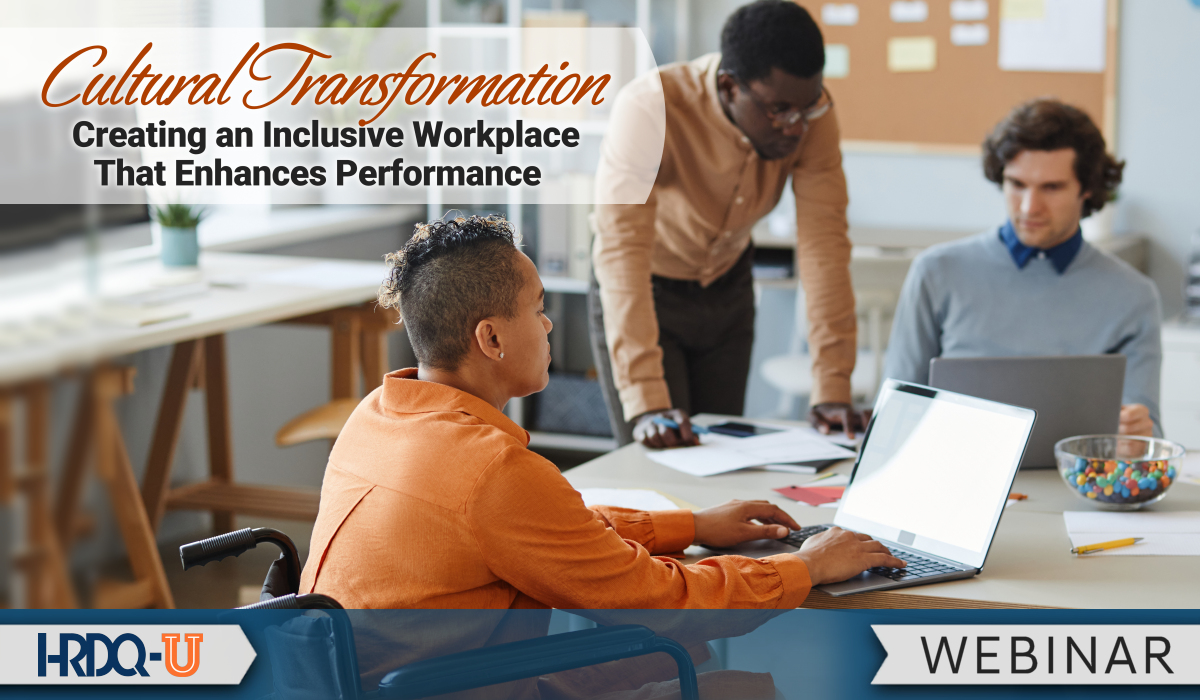- 827 Lincoln Ave. #B-10 West Chester, PA 19380
- support@hrdq.com
- +1-610-279-2002
Quick Links
Menu
Featured Topics
Menu
Total Results
We could not find what you're looking for. Please try again.No Record Found

When you think of leadership qualities, some words that come to mind are strategic, intelligent, forward-thinking, or demanding. Words like empathy, authenticity, or mindfulness are less likely to make the list – until recently. We’re evolving in our perception of leaders and our expectations of them. Therefore, becoming aware of our unconscious or implicit bias is an important step for leaders to take action to disrupt biases and move their organizations forward. Doing so will not only help to attract and retain diverse talent but also create inclusive workplace cultures.
It’s important that we don’t confuse organizational culture with values or mission statements, although both can help define it. Culture is created through consistent and authentic behaviors, not press releases or policy documents. You can watch company culture in action when you see how a manager responds to a crisis, how a team adapts to new customer demands, or how a manager corrects an employee who makes a mistake. If we say that we are kind, we listen, and we care, then we should see these values in action by everyone every day.
In the webinar, learn how to promote diversity and inclusion in the workplace. Curated for human resources professionals and business leaders seeking practical, proven tools and methods for fostering change in promoting diversity, equity, inclusion, and belonging (DEIB) within their organizations. By recognizing the business imperative for these values, this session will help participants build their cultural competency and awareness of unconscious bias, which is essential for cultivating inclusive work environments. We are all biased to some degree. Our unique experiences and backgrounds shape who we are, and our dimensions of diversity – race, ethnicity, gender, height, weight, sexual orientation, place of birth, and other factors – impact the lens through which we view the world.
Diversity expert Patricia Bradley helps you recognize and acknowledge your biases when making decisions, engaging with colleagues, and working effectively in today’s organizations through compelling examples that explore the most common forms of unconscious bias and its implications. Using the Cycle of Socialization framework, participants will explore ways to transform their workplace cultures through actionable strategies and gain the awareness and sensitivity to remove structural and social barriers, how to promote diversity and inclusion in the workplace, and avoid behaviors that give the appearance of partiality.
Cultural incompetence in the business community can lead to dire consequences, but the unobservable effects can go unnoticed until the threat of a class action suit. The harm to individuals caused by cultural incompetence is a concern only to the extent that it is referenced in terms of cost to the institution. The success of the future workplace requires the creation of inclusive environments that enhance retention and offer opportunities for our talent to thrive and grow.


From This to That. Transform Your Culture and Improve Employee Engagement Webinar.
This exclusive, paid online event is designed for human resources professionals and business leaders who want to create thriving workplace cultures that promote retention, productivity, and collaboration. Participants will learn practical strategies and proven techniques to transform the workplace into an environment where employees thrive, and diversity is embraced.
Register today. Space is limited. Save 10% when you register for this event using the link below.
Patricia Bradley is the President and CEO of Carrington Consortium LLC, a vet- and woman-owned small business, that offers strategic planning, leadership, and DE&I services. As a senior certified professional (SHRM-SCP) and retired U.S. Army Lieutenant Colonel, she excels in talent management, cultural transformation, and equipping diverse leaders. With a focus on organizational development, Patricia empowers companies and employees to thrive through diversity. She holds an MBA and Master’s degrees in HR development and health administration.
Carrington Consortium LLC (Carrington) is a woman- and veteran-owned small business located in San Antonio, Texas. Carrington offers extensive expertise in Human Resources Management, Strategic Planning, and Learning & Development. Spearheaded by its owner, Patricia Bradley, Carrington merges senior military leadership with corporate industry expertise to deliver comprehensive workforce development solutions to customers. Doing things right speaks to our focus on efficiency, accuracy, and compliance. We understand that customers have the power to choose – why not choose a team of highly skilled, certified professionals who know what it takes to impact employee engagement and improve business results?
Learn more at Carringtonconsortium.com

Sign up to be notified of upcoming live webinars, in-depth workshops, podcasts, blog posts, promotions and much more. Stay ahead of the curve and subscribe for FREE today!